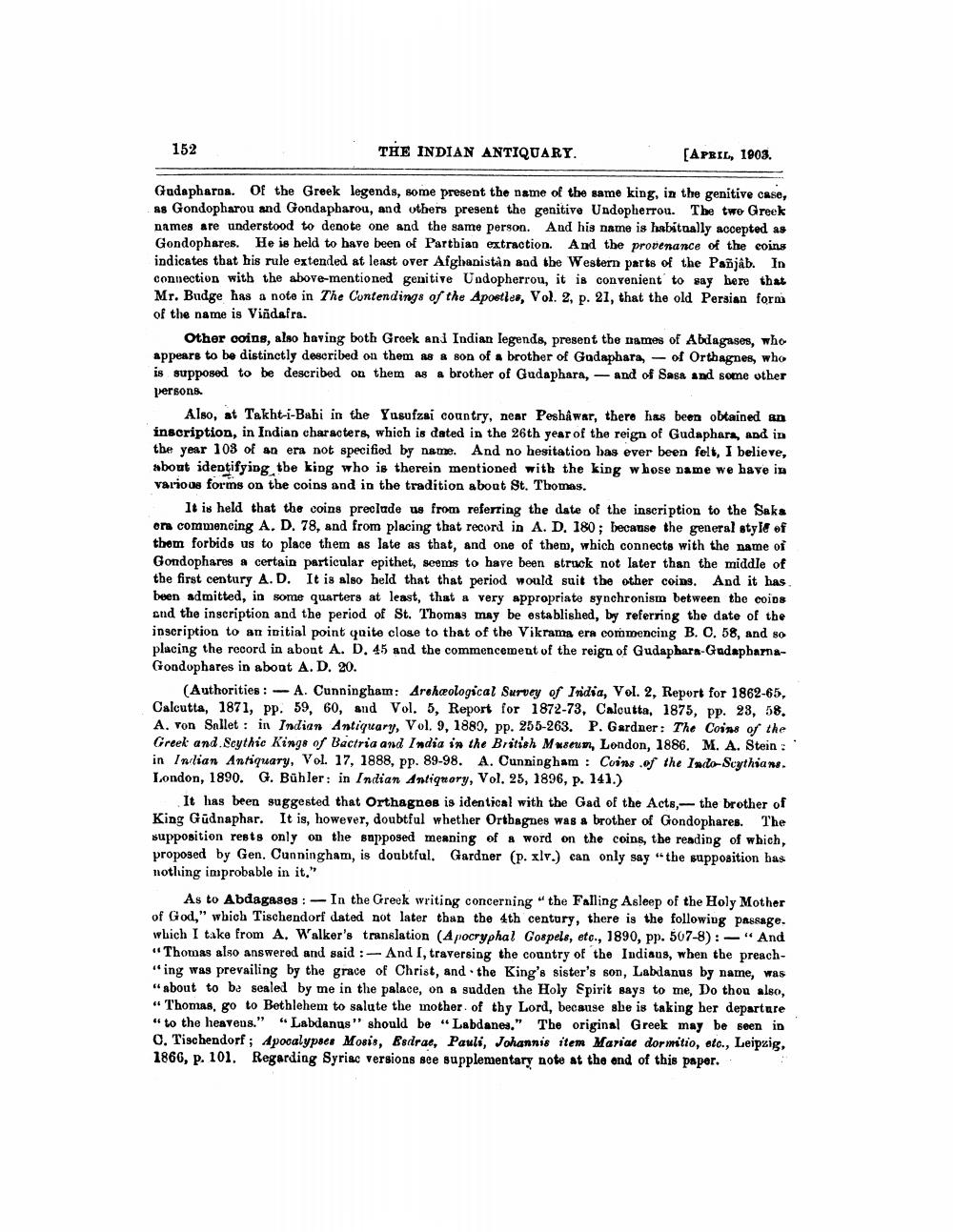________________
152
THE INDIAN ANTIQUARY.
[APRIL, 1903.
Gudapharna. Of the Greek legends, some present the name of the same king, in the genitive case, as Gondopharou and Gondapharou, and others present the genitive Undopherrou. The two Greek names are understood to denote one and the same person. And his name is habitually accepted as Gondophares. He is held to have been of Partbian extraction. And the provenance of the coins indicates that his rule extended at least over Aighanistan and the Western parts of the Pañjab. In connection with the above-mentioned genitive Uodopherrou, it is convenient to say here that Mr. Budge has a note in The Contendings of the Apostles, Vol. 2, p. 21, that the old Persian form of the name is Vindafra.
Other coins, also having both Groek and Indian legends, present the names of Abdagases, who appears to be distinctly described on them as a son of a brother of Godaphara, - of Orthagnes, who is supposed to be described on them as a brother of Gudaphara, - and of Sasa and some other persons
Also, at Takht-i-Babi in the Yusufzsi country, near Peshawar, there has been obtained an inscription, in Indian characters, which is dated in the 26th year of the reign of Gudaphars, and in the year 108 of an era not specified by name. And no hesitation bas ever been felt, I believe, about identifying the king who is therein mentioned with the king whose name we have in various forms on the coins and in the tradition about St. Thomas.
It is held that the coins precludo us from referring the date of the inscription to the Saks era commencing A. D. 78, and from placing that record in A. D. 180; because the general style of them forbids us to place them as late as that, and one of them, which connects with the name of Gondophares a certain particular epithet, seems to have been struck not later than the middle of the first century A.D. It is also held that that period would suit the other coins. And it has been admitted, in some quarters at least, that a very appropriate synchronism between the coids and the inscription and the period of St. Thomas may be established, by referring the date of the inscription to an initial point quite close to that of the Vikrama era commencing B. O. 58, and so placing the record in about A. D. 45 and the commencement of the reign of Gudaphara-GadapharnaGondophares in about A.D. 20.
(Authorities :- A. Cunningham: Archeological Survey of India, Vol. 2, Report for 1862-65, Calcutta, 1871, pp. 59, 60, and Vol. 5, Report for 1872-73, Calcutta, 1875, pp. 23, 58. A. Fon Sallet : in Indian Antiquary, Vol. 9, 1889, pp. 255-263. P. Gardner: The Coins of the Greek and. Scythic Kings of Bactria and India in the British Museum, London, 1886. M. A. Stein: in Indian Antiquary, Vol. 17, 1888, pp. 89-98. A. Cunningham: Coins of the Indo-Scythians. London, 1890. G. Bühler: in Indian Antiquory, Vol. 25, 1896, p. 141.)
It has been suggested that Orthagnes is identical with the Gad of the Acts, the brother of King Gudnaphar. It is, however, doubtful whether Ortbagnes was a brother of Gondophares. The supposition rests only on the supposed meaning of a word on the coins, the reading of which, proposed by Gen. Cunningham, is doubtful. Gardner (p. xlv.) can only say “the supposition has nothing improbable in it."
As to Abdagases: - In the Greek writing concerning the Falling Asleep of the Holy Mother of God," which Tischendorf dated not later than the 4th century, there is the following passage. which I take from A. Walker's translation (Apocryphal Gospels, etc., 1890, pp. 507-8): "And "Thomas also answered and said :- And I, traversing the country of the Indians, when the preach"ing was prevailing by the grace of Christ, and the King's sister's son, Labdanus by name, was “about to be sealed by me in the palace, on a sudden the Holy Spirit says to me, Do thou also, " Thomas, go to Bethlehem to salute the mother of thy Lord, because she is taking her departure " to the heavens." "Labdangs" should be “Labdanes." The original Greek may be seen in 0. Tischendorf; Apocalypses Mosis, Esdrae, Pauli, Johannis item Mariae dormitio, ato., Leipzig, 1866, p. 101. Regarding Syriac versions see supplementary note at the end of this paper.




